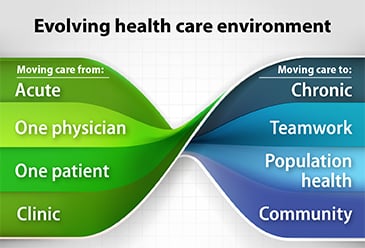As health care continues to evolve at a rapid pace, physicians are anticipating the major issues coming in the future and working to shape them through three key initiatives.
Taking a cue from hockey great Wayne Gretzky—who attributed his success to skating “to where the puck is going to be, not where it has been”—physicians discussed how to ensure the success of the medical profession and the good health of America’s patients in the years ahead during a panel discussion Monday at the 2014 AMA Annual Meeting.
“We are trying to get out ahead and not only prepare but shape the future that is coming down the pike for physicians and our patients,” said David O. Barbe, MD, chair of the AMA Board of Trustees.
Through the three core initiatives of its strategic plan, the AMA is identifying emerging trends and working toward innovations that are needed for physicians to thrive in a new era of health care. “We are gaining some very valuable insights that we believe will help us help our patients,” Dr. Barbe said.
To start, the next generation of physicians will be better prepared for the challenges of the future, thanks to the AMA’s Accelerating Change in Medical Education initiative. The AMA is working with 11 medical schools awarded grants of $1 million each to implement bold innovations in how students are trained.
“We’re building brick by brick the future medical school,” said Mark Quick, EdD (pictured above), AMA vice president of education outcomes.
The initiative is refocusing med school curriculum to align with how health care is pivoting from acute to chronic care, from individual physicians to health care teams, from treatment of single patients to managing population health and from health care in the clinic to healthy living in the community.
Medical students will be trained as expert “adaptive learners,” who will have the skill set to successfully adjust to new situations and inspire and empower others to adapt with them.
In its Professional Satisfaction and Practice Sustainability initiative, the AMA is making sure that physicians already in practice will thrive in the changing health care environment.
“Most physicians understand that things probably are going to be different five or 10 years from now,” said Jay Crosson, MD, who heads up the initiative. “But there’s a lack of clarity about what that world—or worlds—will look like.”
The AMA last year released a study conducted by the RAND Corporation that looked at the primary drivers of physicians’ professional satisfaction to inform the AMA’s efforts to improve today’s practice environment. The AMA is developing practical resources to help physicians implement improvements that will address some of the dissatisfaction factors.
The AMA also is working with RAND to produce a second study that will identify which care delivery and payment models will be best for physicians and patients in the coming years.
Looking at the base of the iceberg in terms of Americans’ health, the AMA’s Improving Health Outcomes initiative is taking on two of the leading causes of death and disability—type 2 diabetes and heart disease. While 26 million Americans have diabetes, another 79 million have prediabetes. Meanwhile, 67 million adults—one in three—have high blood pressure, said Karen Kmetik, PhD, who leads the initiative.
Applying the principles of health care of the future, the AMA is finding ways to impact population health and maximize community resources to help keep patients healthy through strategic clinic-community linkages. Pilot programs are underway for both diseases.





